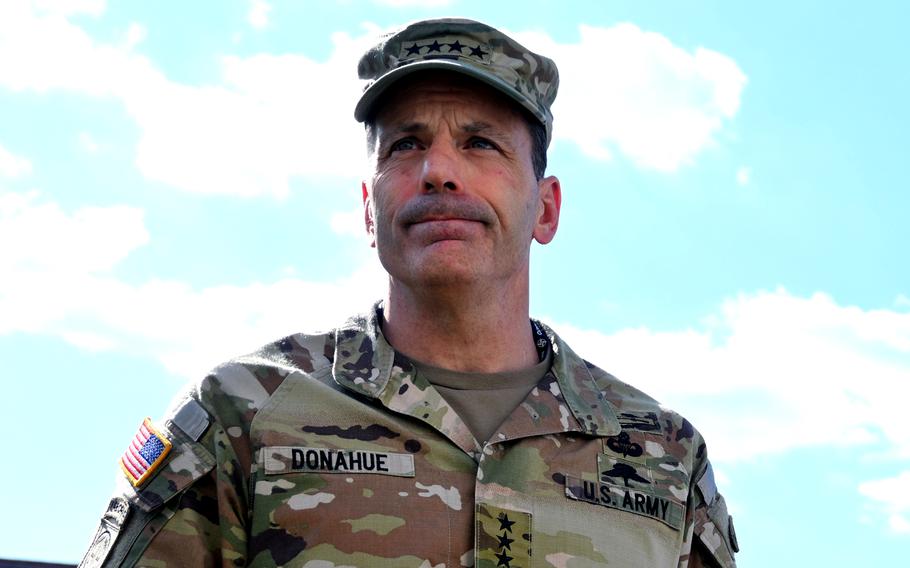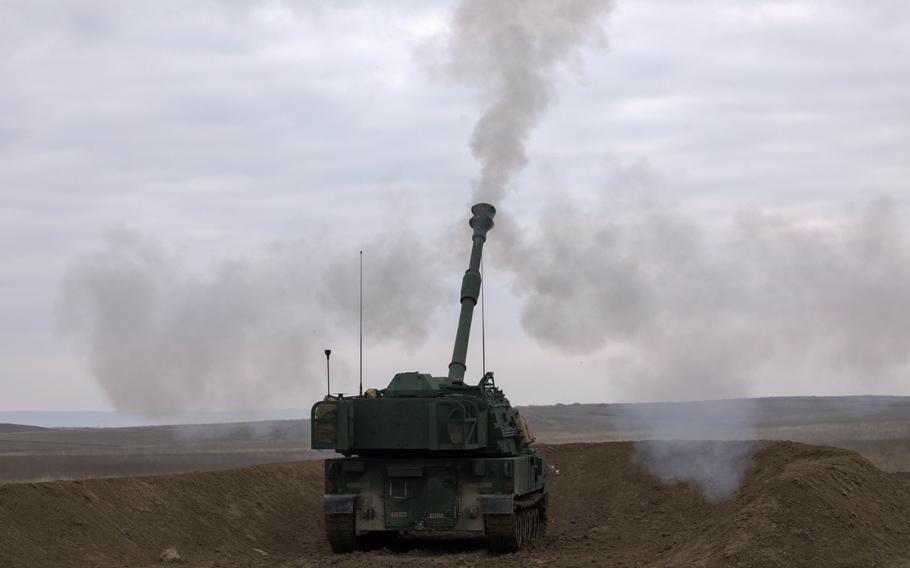
Army Sgt. 1st Class Matthew Pope of the 2nd Multi-Domain Task Force hand-launches a homemade, 3D-printed fixed-wing drone at the Joint Multinational Readiness Center in Hohenfels, Germany, April 11, 2025. The task force and the 56th Artillery Command are being combined, Gen. Christopher Donahue, commander of U.S. Army Europe and Africa, said June 25, 2025. (Lydia Gordon/Stars and Stripes)
STUTTGART, Germany — The U.S. Army is merging two of its newest strategic units in Europe into one headquarters as part of a broader transformation that could serve as a template for the whole service, a four-star commander said this week.
The 56th Artillery Command and 2nd Multi-Domain Task Force, both under U.S. Army Europe and Africa, are being combined, Gen. Christopher Donahue said Wednesday.
“We’re the test bed,” Donahue, who leads the Army in Europe and oversees NATO Land Command, said during a presentation at the Association of the U.S. Army in Washington.
Going forward, multidomain task forces and artillery units “are probably going to morph into something a little bit different,” Donahue said.

Gen. Christopher Donahue is seen outside his headquarters in Wiesbaden, Germany, April 9, 2025. The commander of U.S. Army Europe and Africa said June 25 that the 56th Artillery Command and the 2nd Multi-Domain Task Force are being combined. (Michael Abrams/Stars and Stripes)
Donahue laid out a series of initiatives underway aimed at transforming how U.S. and allied ground forces fight together, drawing heavily from recent global conflicts and ongoing experimentation.
Among the areas being reexamined is how the Army manages artillery firing and air defense, he said.
“Why are we the only service that has two branches for offensive-defensive fires? An airplane doesn’t have that. A ship doesn’t have that,” Donahue said. “I think we have to dramatically … rethink how we do that. It’s offensive, defensive fires. It’s not air defense.”
Donahue’s comments come as units are drawing lessons from the ongoing Russia-Ukraine war and the Middle East.
“We just had people in Israel,” he said. “We send people throughout the world to watch and see what’s going on.”
Much of the Army’s work in Europe centers on drones, electronic warfare, and building up a next-generation command and control network to handle it all.
That focus requires contractors to develop weapons and other systems quickly and inexpensively, Donahue said.
“The standard for industry is that anything we shoot, it has to be cheaper than what we’re shooting down,” he said.
Donahue also said one of the first questions he asks when developers pitch new systems is whether they’ve approached the Ukrainians to test it out first.

An M109A7 Paladin from the 1st Battalion, 9th Field Artillery Regiment fires an artillery round during exercise Dynamic Front at Polatli Training Area in Turkey in 2024. The exercise was led by the Germany-based 56th Artillery Command, which is being combined with the 2nd Multi-Domain Task Force, commander of U.S. Army Europe and Africa Gen. Christopher Donahue said June 25, 2025. (Catalina Carrasco/U.S. Army)
“And if the answer is no, I’ll say, ‘Why?,’” Donahue said. “Because that’s where you get into an environment where we actually know, does it work?”
For U.S. and NATO ground forces, the heart of deterrence efforts centers around the Baltics, he said. Donahue said allies face “arguably the best A2-AD bubble in the world” there, referring to Russian anti-access and area denial capabilities in its exclave of Kaliningrad.
“They (the Russians) have mass and momentum on you,” Donahue said. “You have a very limited space to maneuver, and they have this giant umbrella over top. So how do you destroy that? How do you get to deterrence?”
A strategy to address that scenario has already been designed and presented to senior U.S. and NATO leaders, Donahue said. The challenge now is implementation.
“We built that plan, we designed it, we modeled it. In fact, we just talked to the chairman of the Joint Chiefs about it,” Donahue said.